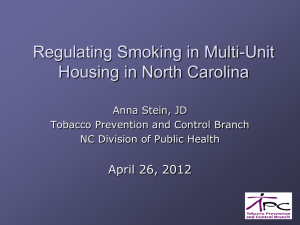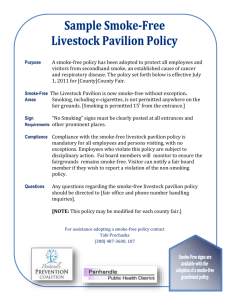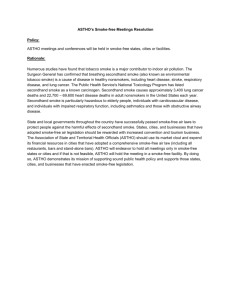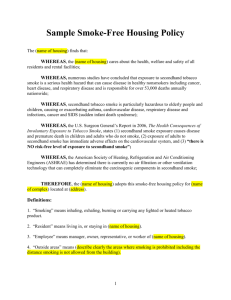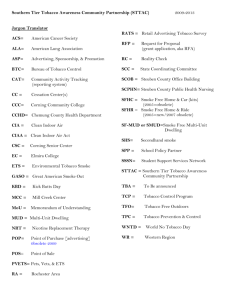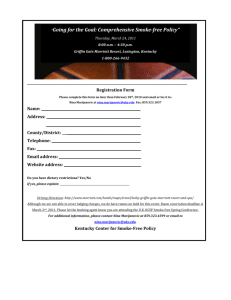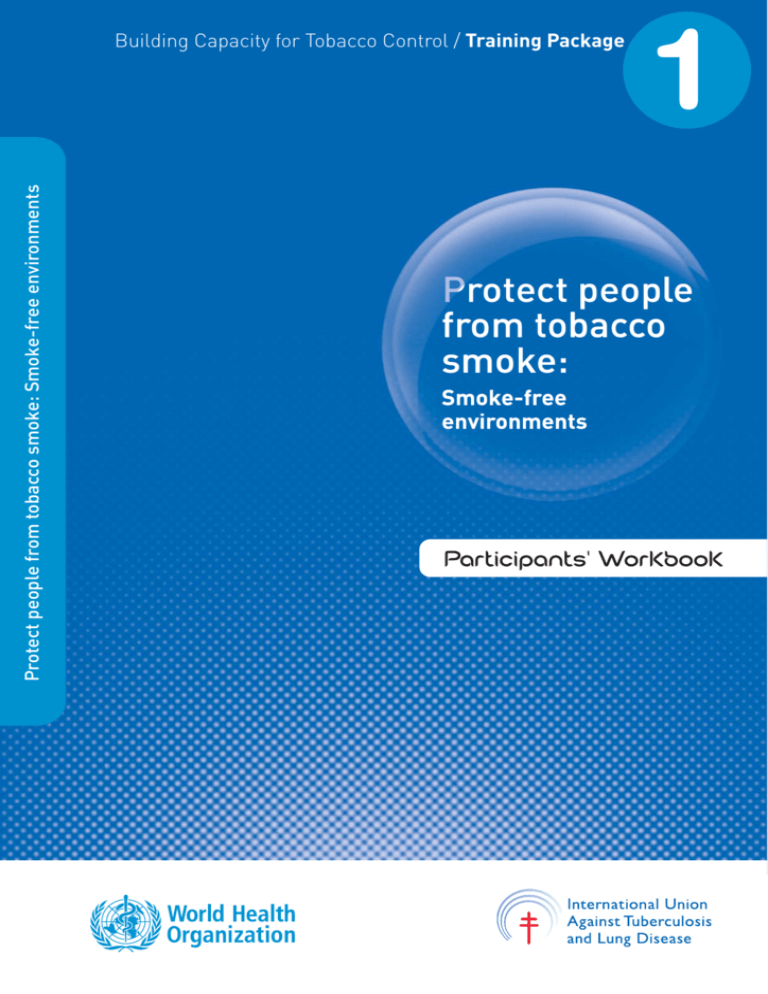
Protect people from tobacco smoke: Smoke-free environments
Building Capacity for Tobacco Control / Training Package
1
Protect people
from tobacco
smoke:
Smoke-free
environments
WHO Library Cataloguing-in-Publication Data
Building capacity for tobacco control: training package.
Contents: 1.Protect people from tobacco smoke: smoke-free environments - 2.Warn about the dangers of tobacco: packaging and labelling of
tobacco products - 3.Tobacco advertising, promotion and sponsorship: enforcing comprehensive bans.
1.Tobacco smoke pollution - prevention and control. 2.Smoking - prevention and control. 3.Tobacco-derived products labelling. 4.Tobacco control
campaigns. 5.Teaching materials I.World Health Organization. II.International Union against Tuberculosis and Lung Disease.
ISBN 978 92 4 150135 4
(NLM classification: HD 9130.6)
© World Health Organization and International Union against Tuberculosis and Lung Disease 2011
All rights reserved. Publications of the World Health Organization can be obtained from WHO Press, World Health Organization, 20 Avenue Appia,
1211 Geneva 27, Switzerland (tel.: +41 22 791 3264; fax: +41 22 791 4857; e-mail: bookorders@who.int). Requests for permission to reproduce
or translate WHO publications – whether for sale or for noncommercial distribution – should be addressed to WHO Press, at the above address
(fax: +41 22 791 4806; e-mail: permissions@who.int).
The designations employed and the presentation of the material in this publication do not imply the expression of any opinion whatsoever on
the part of the World Health Organization concerning the legal status of any country, territory, city or area or of its authorities, or concerning the
delimitation of its frontiers or boundaries. Dotted lines on maps represent approximate border lines for which there may not yet be full agreement.
The mention of specific companies or of certain manufacturers’ products does not imply that they are endorsed or recommended by the World
Health Organization in preference to others of a similar nature that are not mentioned. Errors and omissions excepted, the names of proprietary
products are distinguished by initial capital letters.
All reasonable precautions have been taken by the World Health Organization to verify the information contained in this publication. However,
the published material is being distributed without warranty of any kind, either expressed or implied. The responsibility for the interpretation and
use of the material lies with the reader. In no event shall the World Health Organization be liable for damages arising from its use.
Design and layout: Bernard Sauser-Hall
Printed in France
Protect people from tobacco smoke:
Smoke-free environments
Participants’ Workbook
Protect people from tobacco smoke: Smoke-free environments
Participants’ Workbook
CONTENT
Session 1: Welcome, workshop expectations and issue overview...........................................................................
5
Session 2: Smoke-free in action.................................................................................................................................
5
Session 3: Countering opposition...............................................................................................................................
6
Sessions 4 to 9: Strategic planning sessions ...........................................................................................................
6
Session 4: Assessment of current situation: activities, SWOT analysis, stakeholders and other factors ............
7
Session 5: Legislation analysis and development..................................................................................................... 15
Session 6: Information and communication.............................................................................................................. 19
Session 7: Enforcement .............................................................................................................................................. 21
Session 8: Evaluation and monitoring........................................................................................................................ 23
Session 9: Consolidation and wrap-up ...................................................................................................................... 28
Protect people from tobacco smoke: Smoke-free environments
Session 1 / Welcome, workshop expectations and issue overview
SESSION 1
Welcome, workshop expectations and issue overview
Exercise: Key messages on protection from second-hand tobacco smoke.
(Follows presentation on “Why smoke-free environments? The problem and how to solve it)
The purpose of this exercise is to give participants the opportunity to present the information that has been provided
in a way they think would be effective in influencing their policy-makers.
Scenario:
Your Minister [or mayor or other relevant political leader] is considering developing new legislation to address
protection from second-hand tobacco smoke in the workplace. However, he/she also realizes that there may be
opposition to strong legislation, and wants to better understand the issues before moving forward.
Your task:
Prepare a brief summary of the issues for the minister, addressing:
− why people need to be protected from second-hand smoke;
− why 100% smoke-free environments are necessary to provide protection;
− the impact of smoke-free environments on health, the economy, and tobacco use;
− any international policy guidelines or recommendations on best practice that could guide strong national
[or local] legislation.
You may choose to summarize these issues in writing (bullet points, no more than half a page), OR you may prepare
notes for a verbal presentation (no more than five minutes’ duration).
Use the workshop presentation, the WHO policy recommendations, and the WHO FCTC Article 8 guidelines as
reference documents as necessary.
You have 15 minutes to complete this exercise. You will then have the opportunity to review your work with one
of the facilitators.
SESSION 2
Smoke-free in action
No exercises in this session.
5
Protect people from tobacco smoke: Smoke-free environments
Participants’ Workbook
SESSION 3
Countering opposition
Exercise: Countering opponents’ arguments
The purpose of this exercise is to allow participants to practice using the arguments they have heard to counter opponents. Participants will prepare the exercise in small groups, and present the results in a plenary “role play” exercise.
Task A:
You are asked to give a live radio interview to an interviewer who is very hostile to legislation that will make public
places and workplaces smoke-free. Prepare a list of arguments that you expect the interviewer to make, and
explain how you can respond effectively. Choose one or more participants to help you act out the interview in role
play in the next session.
Task B:
You represent one or more public health organizations making a presentation to municipal politicians considering
a 100% smoke-free law. Your presentation follows one by restaurant owners who want separate areas for smokers.
The restaurant owners claim that:
− second-hand smoke is not a health hazard;
− smoke-free restaurants will cause them to lose business;
− the government has no right to interfere in their business.
Develop a three-minute presentation that puts forward your organization’s position and counters the impact of the
restaurant owners’ presentation. Prepare to respond to brief follow-up questions from the councillors. Choose one
or more participants to join you in a role play of the presentation in the next session.
This is a strategic exercise as well as a role play. If all participants in each group do not participate in the role play,
they should all be involved in the discussion of strategy, including:
− anticipating the arguments;
− preparing the responses;
− identifying which role play group(s) would be the most convincing representatives.
SESSION 4 to 9
Strategic planning exercises
The overall objective of the strategic planning exercises is for participants to develop a plan of action for each
jurisdiction. The exercise is divided into smaller components and exercises, each of which comprises tasks
designed to take the participants progressively from assessing their current situation through to developing
an action plan. This includes setting priorities and fixing a timetable for implementation.
All exercises will be conducted in small groups of 3 – 4 participants from the same jurisdiction. The groups will
remain the same throughout the workshop and will work with the same facilitator.
The workshop facilitator will introduce each exercise in plenary session. He/she should highlight the structure
and objectives with a brief summary of the main elements of best practice, and should answer any questions that
participants may have.
The group facilitator will take the jurisdiction group through the tasks identified under each exercise.
The discussions should be focused and strategic, and should lead to best practices as much as possible.
The final outcome of the strategic planning sessions is a cohesive action plan for each jurisdiction. The Strategic
planning flowchart below summarizes the process and outcome of the strategic planning exercises.
6
Protect people from tobacco smoke: Smoke-free environments
Session 4 / Assessment of current situation: Activities, SWOT analysis, stakeholders and other factors
Strategic planning flowchart
General Knowledge session:
Why smoke-free? The problem, the solution
Best practice case study
Countering opponents
Local Knowledge session:
Current assessment – legislative analysis,
SWOT analysis, stakeholder mapping
Need to revise or draft new legislation
Don’t need to revise or draft new legislation
Develop legislation drafting/revision plan
Develop communication plan
Develop implementation and enforcement plan
Develop monitoring and evaluation plan
Pull together into detailed action plan (what, who, how?)
Define priorities and timetable
Define resources and assistance needed
SESSION 4
Assessment
Assessmentofofcurrent
currentsituation:
situation:Activities,
Activities,SWOT
SWOTanalysis,
analysis,stakeholders
stakeholdersand
andother
otherfactors
factors
2 hours
Exercise: Assess the current situation, including current activities, stakeholders and gaps
This exercise follows the presentations on the current situation in the participating jurisdictions. It is designed
to obtain a clearer picture of participants’ perceptions of the current situation.
Expected outcomes are:
− assessment of the relevance of activities that have already been conducted or are planned;
− identification of activities that need to be developed, or broad gaps between best practice and the current
situation, for each of the components necessary for a comprehensive strategy;
− a list of areas and activities that need to be developed (strategies to address these will be the focus of subsequent
exercises);
− identification of the main strengths, weaknesses, opportunities and threats within the jurisdiction for developing,
implementing and enforcing smoke-free legislation/regulation;
− mapping of main stakeholders and their current or potential role/contribution.
7
Protect people from tobacco smoke: Smoke-free environments
Participants’ Workbook
The exercise is divided into three tasks:
Task 1: Identify activities to be developed, gaps and relevance of activities planned (1 hour).
Task 2: Identify the main stakeholders in developing, implementing and enforcing smoke-free legislation (30 minutes).
Task 3: Strengths, weaknesses, opportunities, threats (SWOT) analysis (30 minutes).
Task 1: Identify gaps and relevance of activities planned.
1 hour
In your small group, use the tables below to:
− briefly identify activities carried out or planned under each heading;
− quickly assess relevance of the activities;
− identify activities needed or broad gaps in activities;
− pick up any important discussion points that need to be addressed.
If the discussion moves away from the main topic and looks likely to be lengthy, please register the issue under
“elements for further discussion”. Explain that the issue will addressed during another session, or one-on-one
with a facilitator.
Summarize the identified gaps and elements for further discussion on a flipchart, using the flipchart recording
format provided on page 9.
1.a. What has been done or is planned to inform the public at large and mobilize public opinion for the
regulation/legislation that is coming into force?
Activities carried out/planned
8
Details
Relevance/usefulness according
to best practice/comments
Protect people from tobacco smoke: Smoke-free environments
Session 4 / Assessment of current situation: Activities, SWOT analysis, stakeholders and other factors
b. What do you think is missing, and what activities need to be developed?
Gaps identified
Elements for further discussion
2. a. What has been done or is planned to inform and mobilize key opinion leaders (e.g. media editorial boards and
owners, business and community leaders, leading politicians)?
Activities carried out/planned
Details
Relevance/usefulness according
to best practice/comments
b. What do you think is missing?
Gaps identified
Elements for further discussion
9
Protect people from tobacco smoke: Smoke-free environments
Participants’ Workbook
3. a. What has been done or is planned to inform and mobilize key decision-makers (government officials, parliamentarians)?
Activities carried out/planned
Details
Relevance/usefulness according
to best practice/comments
b. What do you think is missing?
Gaps identified
Elements for further discussion
4. a. What has been done or is planned to build confidence, develop capacity, and prepare for successful enforcement?
Activities carried out/planned
10
Details
Relevance/usefulness according
to best practice/comments
Protect people from tobacco smoke: Smoke-free environments
Session 4 / Assessment of current situation: Activities, SWOT analysis, stakeholders and other factors
b. What do you think is missing?
Gaps identified
Elements for further discussion
5. a. What has been done or is planned to monitor and counter tobacco industry disinformation
and tactics?
Activities carried out/planned
Details
Relevance/usefulness according
to best practice/comments
b. What do you think is missing?
Gaps identified
Elements for further discussion
11
Protect people from tobacco smoke: Smoke-free environments
Participants’ Workbook
6. a. What has been done or is planned to monitor compliance and evaluate impact?
Activities carried out/planned
Details
Relevance/usefulness according
to best practice/comments
b. What do you think is missing?
Gaps identified
Elements for further discussion
RECORDING FORMAT FOR FLIPCHART
SUMMARY − Gaps identified
Inform and mobilize public opinion?
Mobilize key opinion leaders?
Mobilize key decision-makers?
Confidence, capacity and preparation to enforce
Monitor and counter tobacco industry disinformation
Monitor compliance and evaluate impact
12
Elements for further discussion
Protect people from tobacco smoke: Smoke-free environments
Session 4 / Assessment of current situation: Activities, SWOT analysis, stakeholders and other factors
Task 2: Identify the main stakeholders for promoting, implementing and enforcing smoke-free legislation/
regulation.
30 minutes
1. Ask participants to name the organizations involved in or responsible for promotion, implementation and
enforcement. Steer the group discussion to identify organizations and individuals that are really important,
committed or bring something specific. Please ensure that participants do not just name all the organizations
involved in tobacco control but only those that are making, or should be making, a contribution to the
implementation and enforcement of smoke-free legislation.
2. Ask participants the scope of the powers/responsibilities and/or areas of expertise of these organizations and
individuals.
3. Discuss the current or planned involvement and contribution of these organizations and individuals.
4. Assess the quality of the working relationship.
RECORDING FORMAT FOR FLIPCHART
Stakeholders
Organization/sector/
individuals
e.g. ….
Scope of power or
responsibility and
area of expertise
Power/responsibility
e.g. …
Stage of current
involvement and
specific activities
e.g. …
Working relationship
e.g. …
Government, NGO, civil
society organization,
private sector, other
•
•
•
•
Direct legal power
Inspection/reporting
Enforce/fines
Indirect legal power
(citizen’s rights)
• Raise awareness
among media and
public opinion
• Report/complain
• Scientific authority
• Not yet engaged
• Early stage of involvement and discussions
• Some early
activities/wins
• Fully engaged and
comprehensively
supportive
• Working well
• Needs to be developed
• Some early
activities/wins
• Issues/difficulties
Expertise/Knowledge
e.g. …
NGO is involved in running a series of training
and sensitization workshops
• Scientific (monitoring/auditing)
• Law enforcement
• Health (clinical or
policy)
• Communications,
advocacy
• Education and training
• Labour relations
(unions etc.)
• Corporate (tourism,
hospitality)
Specific activities
e.g. …
13
Protect people from tobacco smoke: Smoke-free environments
Participants’ Workbook
Task 3: SWOT analysis.
30 minutes Collect the participants’ spontaneous reactions to the question:
What do you perceive as strengths, weaknesses, opportunities and threats for your jurisdiction as it tries to
develop, implement and enforce smoke-free legislation successfully?
RECORDING FORMAT FOR FLIPCHART
Strengths
Weaknesses
Opportunities
Threats
Plenary Session
15−30 minutes Each small group should briefly (5 minutes or so) present the results of its discussions
to the larger group.
If the workshop is shorter than the recommended allocated time, it may not be feasible to work through the detailed
three-part situation assessment exercise provided in Session 4 of the Facilitators’ Guide and Participants’ Workbook.
The following is a simplified alternative.
14
Protect people from tobacco smoke: Smoke-free environments
Simplified Situation Assessment (Session 4)
Session 5 / Legislation analysis and development
Approximate time needed: 1 to 1.5 hours
Instead of the detailed three-part exercise, use the following guiding questions. Facilitators should use their experience to draw
out important points and to clarify issues.
The answers should be recorded on a flip chart.
Based on the presentations you’ve heard, how would you rate the situation in your [city/state or province/country] with regard to:
• Public knowledge and attitudes toward second-hand tobacco smoke? (Discuss level of knowledge, common perceptions and
misperceptions.)
• Involvement and capacity of key stakeholders needed to promote and implement smoke-free environments?
(Discuss governments, NGOs and other civil society, medical professionals, others. Who are they, how active are they, what are they
currently doing to promote smoke-free environments?)
• Political will?
(Discuss who the key decision makers are and what their knowledge and commitment is. Are their positions influenced by the tobacco
industry? Through what relationships or factors?)
• Legislation?
(Discuss in brief only, since a detailed legislation analysis will follow. Is your current legislation consistent with the Article 8 guidelines?)
• How soon do you think you can achieve comprehensive smoke-free legislation in your [city/state or province/country] (all indoor workplaces
and public places)?
• Very briefly, what do you think the key obstacles are to achieving this?
• Very briefly, what strengths can you build upon to achieve this?
SESSION 5
Legislation analysis and development
Exercise 1: Assess whether your jurisdiction has best practice, enforceable legislation/regulations that are
generally complied with, and if new or amended legislation is needed
30 minutes – 1 hour
Analyse the legislative situation in your jurisdiction guided by the Legislation analysis decision-tree chart below
(Figure 3). This decision tree addresses the state of current legislation, enforcement of and/or compliance with that
legislation, and gives a menu of options for moving forward.
The outcome of the legislation analysis will determine the main focus of strategic planning for the workshop. The
three most likely general outcomes are that:
1. The legislation meets best practice in that it provides universal (or very comprehensive) protection from exposure
to second-hand smoke in indoor public places and workplaces, but there are problems with implementation,
enforcement and/or compliance.
Focus of strategic planning: Action plan for addressing relevant implementation, enforcement and/or
compliance issues identified in the strategic analysis.
2. The legislation DOES NOT meet best practice and needs to be amended (or new legislation introduced) to expand
protection.
Focus of strategic planning: a) Action plan for developing and passing the legislation needed to expand protection.
b) Action plan to ensure effective implementation, enforcement and compliance.
3. The legislation DOES NOT meet best practice but the political climate (or other factors) do not lend themselves
to improving the legislation at this time.
Focus of strategic planning: a) Identify what implementation can be done with the current legislation in order
to improve protection. b) Identify what actions can be taken to build political will and public support to improve
the legislation.
15
Protect people from tobacco smoke: Smoke-free environments
Figure 3
Participants’ Workbook
Legislation analysis decision tree
Legislation Analysis Decision Tree
Do you have best practice legislation/regulation [at relevant jurisdictional level]?
(requires all indoor places to be 100% smoke-free with no rooms or areas for smoking inside the building,
as recommended by WHO policy recommendations and Article 8 guidelines)
YES
NO
Is compliance with legislation good?
(people do not smoke in smoke-free buildings; signs are properly displayed;
resulting protection is as legislation intends)
Are you in a position to draft or amend legislation
to meet best practice?
(it is politically feasible; the benefits outweigh risks)
YES
NO
YES
Your jurisdiction
may be able to offer
technical assistance
to others trying to
pass and implement
smoke-free legislation.
Identify why not
For example:
Lack of awareness of legislation
among public or among
institutions covered by legislation?
Lack of enforcement mechanisms?
Lack of deterrent penalties?
Amend or develop
new legislation to
meet best practice
Consider compliance
and implementation
issues at left
NO
Assess how you can work with
what you have
For example:
Can you use innovative enforcement
and communication strategies to
maximize protection?
Can you launch awareness-raising
activities to build political will to
amend or pass new legislation?
Develop strategy based on assessment above
NOTE: THE FOLLOWING EXERCISE MAY BE OMITTED IF PARTICIPANTS HAVE DETERMINED THAT
THEIR LEGISLATION ALREADY REPRESENTS BEST PRACTICE.
Exercise 2: Identify changes needed to existing legislation and regulations to make them consistent with
WHO policy recommendations and Article 8 guidelines, and develop an action plan to secure the adoption
of new or revised legislation/regulations
2.5 hours
Task 1: Facilitators take the group through an analysis of current legislation in light of WHO policy
recommendations and the FCTC Article 8 guidelines, and develop a content outline for new or revised legislation.
Possible issues to be analysed include:
(1 hour)
Scope of legislation
• Ensure that legislation prohibits smoking and tobacco smoke in all indoor or enclosed public places (including
workplaces). If politically feasible, legislation can also prohibit smoking in some outdoor settings, such as
entrances or terraces.
• Ensure that legislation does not prevent other jurisdictions within its scope from passing even stronger protective
measures.
• Ensure that indoor smoking areas are not allowed (this is implicit in the above guidance, but should be clarified
in discussion).
16
Protect people from tobacco smoke: Smoke-free environments
Session 5 / Legislation analysis and development
Definitions
• Ensure that key terms are defined (e.g. workplace, public place, indoors, enclosed, tobacco smoke).
• Are definitions clear and consistent?
• Are definitions sufficiently comprehensive to cover work vehicles, semi-enclosed areas, and other types of indoor
workplaces and public places?
Provisions to facilitate implementation and enforcement
• There are requirements for signs (content, size, location).
• Ashtrays are prohibited in venues where smoking is prohibited.
• Managers/owners of establishments are responsible for ensuring compliance on their premises, for posting
required signs, and for ensuring that ashtrays are removed from smoke-free venues.
Enforcement mechanisms and infrastructure
• The agency responsible for enforcement is identified.
• Enforcement mechanisms and structures are identified and are practical.
• Minimum penalties are specified and are significant enough to be deterrent.
• Penalties include financial and administrative sanctions where legally possible (such as suspension of a licence
or temporary closure of an establishment).
• The public is empowered to report violations or bring charges (where legally possible).
Flexibility to close loopholes in the future
• Do legislative powers permit implementation of regulations so that unforeseen loopholes can be closed without
amending legislation?
Task 2: Develop an action plan to secure adoption of new or revised legislation/regulations.
(1 hour)
Some possible considerations include:
• Identify the organizations and individuals who will be responsible for drafting the action plan. Are they
knowledgeable, do they need information, or training? Consider all ministries or agencies you may want to
collaborate with in drafting and introducing the legislation (e.g. Ministry of Labour, potential enforcement agencies),
as well as any external legal or technical expertise you may need.
• What are the steps in the legislative process? What are the timelines for each step? Consider relevant factors
that may affect the legislative process (e.g. important elections or the introduction of other major government
policies).
• What activities will be necessary to complete the process of drafting and adoption legislating in your country?
• Identify opportunities and obstacles that you and your country will face in the process.
• Describe how you will use the opportunities and overcome the obstacles.
• Develop a realistic timetable for the major steps in the legislative process.
17
Protect people from tobacco smoke: Smoke-free environments
Participants’ Workbook
Summarize the results of the discussion on a flipchart using the format below.
(30 minutes)
RECORDING FORMAT FOR FLIPCHART
Amendments needed to legislation
Comments
Action plan to secure new or amended legislation
Activity
Responsible
Obstacles/opportunities
Timeline
Plenary session
(15−30 minutes)
Each small group should briefly (5 minutes or so) present the results of its discussions to the larger group.
18
Protect people from tobacco smoke: Smoke-free environments
Session 6 / Information and communication
SESSION 6
Information and communication
Exercise: Develop an information and communication plan to address gaps identified in current situation
assessment
2 hours
Using the information collected during the situation assessment exercise, facilitate the group’s development of
the outline of an information/communication plan. Focus the plan on the same topics as were discussed in the
situation assessment – i.e. inform and mobilize the public, confidence and capacity to enforce, etc.
The question for participants to consider:
From where your jurisdiction stands today, who needs to know what, and how should the message be delivered to
secure support for successful implementation and successful enforcement of smoke-free legislation/regulations?
The exercise is divided into five tasks (20 minutes each):
Task 1: Goal
Identify your communication goal(s). What are you trying to achieve?
Task 2: Audience
Identify target audiences. Who do you want your message to reach?
Task 3: Message
Identify the issues, themes and messages you need to communicate.
Task 4: Messenger Identify who (individual or organization) is best placed to deliver the message.
Task 5: Medium
Identify the most effective format or medium to deliver the message.
There may be several different responses under each task, depending on the audiences and goals identified for
different components of the strategy (e.g. mobilize decision-makers versus enable enforcement).
Task 1: Identify your communication goal(s). What you are trying to achieve? (GOAL)
(20 minutes)
Examples:
• Move public opinion from thinking that second-hand smoke is a nuisance to understanding that it is a threat to
health.
• Secure adoption of legislation by parliamentarians.
• Explain why ventilation is not a suitable alternative to 100% smoke-free buildings.
• Counter tobacco industry media propaganda that restaurants will lose 30% of their business if they go smoke-free.
• Explain the reasons for smoke-free legislation. Raise awareness of the date of entry into force and sanctions.
Task 2: Identify target audience(s). Who do you want your message to reach? (AUDIENCE)
(20 minutes)
Examples could include:
− the public at large
− key opinion leaders
− key decision-makers
− key stakeholders: enforcement authorities, heads of educational facilities and health-care facilities, trade unions,
hospitality industry professionals, health professionals etc.;
− others.
19
Protect people from tobacco smoke: Smoke-free environments
Participants’ Workbook
Task 3: Identify the issues, themes and messages you need to communicate. (MESSAGE)
(20 minutes)
Examples could include:
− health risks of exposure to tobacco smoke and the reasons for smoke-free regulation;
− the existence of smoke-free regulation, its rationale, and how it will be implemented and enforced;
− effective measures to protect the population from exposure to tobacco smoke;
− the role of the tobacco industry in public disinformation;
− countering myths propagated by the tobacco industry on the economic impact, ventilation, freedom etc.;
− the responsibility of employers to protect the health of employees;
− the benefits of smoke-free policies (impact on prevalence, immediate impact on employees’ health, protection of
young people, denormalising tobacco use, healthier workplaces, cost reductions).
Task 4: Identify who (individual or organisation) is best placed to deliver the message. (MESSENGER)
(20 minutes)
Examples could include:
− government (which ministries or agencies?);
− NGOs (which ones?);
− alliances (e.g. NGOs and government);
− political champion;
− others (e.g. trade unions, professional bodies).
Task 5: Identify the most effective format or medium to deliver the message. (MEDIUM)
(20 minutes)
Examples could include:
− mass media;
− earned media through news releases, press conferences or other events;
− web sites;
− information sessions, briefings, seminars, workshops;
− brochures, factsheets;
− internal communication channels (government communications, NGO alliance networks);
− one-on-one communications (briefings of media, legislators or key stakeholders).
Summarize the outcome of discussions on a flipchart using the format below.
(30 minutes)
RECORDING FORMAT FOR FLIPCHART
Communication
goal
Target audience
Themes/messages
Messenger
Delivery
medium/format
Plenary session (15−30 minutes)
Each small group should briefly (5 minutes or so) present the results of its discussions to the larger group.
20
Protect people from tobacco smoke: Smoke-free environments
Session 7 / Enforcement
SESSION 7
Enforcement
Exercise: Develop an enforcement plan to address gaps identified in the current situation assessment
2 hours
Keep in mind that most jurisdictions have secured very good compliance with a very small team of enforcement
officers. A small enforcement force that is proactive and that demonstrates the will to enforce, accompanied by
strong publicity in the media about enforcement efforts, is usually sufficient to achieve acceptable compliance.
Think of examples of other laws or regulations that are complied with in your jurisdiction – such as wearing
seat-belts, helmets etc. – and how that compliance came about.
This exercise is divided into two tasks (20 minutes each)
Task 1: Assess capacity to enforce.
Task 2: Identify how supporting materials to enable successful enforcement (e.g. signs, guidance documents)
will be developed and made available widely.
Task 1: Assess capacity to enforce.
1. Have enforcement authorities, other bodies and individuals been designated? If not, will they be designated?
2. List who has or will have the power to enforce.
3. Have they been informed of their responsibility? If not, how will they be informed of their responsibility?
4. How will they be able to issue fines? Ask participants to describe precisely how this will take place.
5. Have they been trained? If not, how will they be trained? What did or will the training cover?
6. Has a protocol (system and tools) for inspections been developed? If not, how will this be developed? What is
being, or will be, inspected? What are priority locations for inspections, or how will they be determined?
7. Where and how can the general public, owners of premises, managers and others report a violation? Who should
they contact if they need help with enforcement or information? (e.g. web site, helpline etc.)
8. How will you demonstrate the will to enforce? (communication on fines, enforcement and compliance to the
authorities and to the public)
9. How will you monitor compliance? How will you gather information from different government agencies or
departments to monitor fines and compliance?
Task 2: Identify how supporting materials to enable successful enforcement (e.g. signs, guidance
documents) will be developed and made available widely.
Signs
• Have official mandatory signs been developed and printed? If not, will they be? (If signs are not provided to
establishments and institutions, are there specific instructions for producing signs?)
• How is the distribution of signs being organized, or how will it be organized?
• How accessible are the signs? Where can people obtain them?
Guidance documentation
• Has guidance documentation been developed? For whom? What does it cover?
• How is the distribution of the guidance document being organized?
• How accessible is the guidance document? Where can people obtain it?
Fines and sanctions
• Have special books or other materials containing tickets for fines been printed?
• Are these easily available to inspectors and other enforcement staff?
21
Protect people from tobacco smoke: Smoke-free environments
Participants’ Workbook
RECORDING FORMAT FOR FLIPCHART
Plenary session (30 minutes)
Outline of enforcement plan
Actions taken
Actions needed
Designation of enforcement
authorities, bodies, individuals
Who has/will have the power
to enforce? (list)
Have they been informed of their
responsibility? If not, how will they
be informed of their responsibility?
Enforcers’ ability to issue fines
Enforcers’ training?
Protocol (system and tools)
for inspections
Mechanism for the public, owners
of premises, managers etc. to report
a violation or request assistance
(web site, helpline etc.)
Demonstration of will to enforce
(communication on fines,
enforcement and compliance)
Monitoring compliance, gathering
information from government
agencies and departments
Each small group should briefly (5 minutes or so) present the results of its discussions to the larger group.
22
Protect people from tobacco smoke: Smoke-free environments
Session 8 / Evaluation and monitoring
SESSION 8
Evaluation and monitoring
Exercise: Develop a monitoring and evaluation plan to address gaps identified during the situation assessment 6
1.5 hours
Identify priorities for evaluating and monitoring the implementation and impact of smoke-free legislation, taking
into account your level of resources. Identify the activities needed to collect and use data or information that
addresses these priorities.
The exercise is divided into four tasks (10−15 minutes each)
Task 1: Identify baseline data available or planned.
Task 2: Identify your jurisdiction’s resource level.
Task 3: Develop an outline of an evaluation plan, taking into account recommended studies for the resource level
available.
Task 4: Develop a plan to promote and disseminate evaluation results (revise the communication plan as necessary).
Task 1: Identify what baseline data is available. What studies have been conducted so far or are planned
prior to implementation of the legislation?
RECORDING FORMAT FOR FLIPCHART
Measuring
Baseline data available
Studies conducted or planned
Public support
Compliance
Air quality
Employee health
Economic impact
Smoking behaviour
6
Adapted from Centers for Disease Control and Prevention. Evaluation toolkit for smoke-free policies. Atlanta, GA, US Department of Health and Human
Services, 2008 (available at http://www.cdc.gov/tobacco).
23
Protect people from tobacco smoke: Smoke-free environments
Participants’ Workbook
Task 2: Identify the level of resources available for your jurisdiction. Use the definitions below to determine
the category you fall under.
Level 1 - Minimal resources
Definition: Small community partners, health department has no staff working full-time on tobacco (no funding,
no paid staff, volunteers only).
Level 2 - Moderate resources
Definition: Organized community coalition, small health department (limited funding, some paid staff, access
to many volunteers).
Level 3 - Significant resources
Definition: Large community partners, regional or national health department, involvement of other partners
such as voluntary organizations, national organizations, funders, or researchers (significant funding, large paid
staff, large network of volunteers, statistical expertise, and laboratory services).
Resource level of jurisdiction
Task 3: Develop an outline of an evaluation plan, taking into account studies recommended for the appropriate
resource level as set out below.
Level 1 - Minimal resources
Consider the following components for your evaluation plan.
Public support
• Use an existing population health survey, such as an Adult Tobacco Survey (ATS), that includes questions that are
relevant to evaluating public support.
Compliance
• Use an existing population health survey that includes questions that are relevant to evaluating personal and
observed compliance with the legislation in specific settings.
• Organize volunteers to conduct observations in a convenience sample of hospitality venues, or in other types of
venue that are seen as most relevant (probably those perceived to present the greatest challenges to compliance).
Air quality monitoring
• Rent or borrow an air quality monitoring device and have volunteers collect data in a sample of hospitality venues,
or in other venues that are seen as most relevant (probably those perceived to present the greatest challenges
to compliance).
• Obtain the assistance of an experienced institution (possibly outside your jurisdiction) to analyse and summarize
the data.
Employee health
• An original study is not feasible.
• Summarize the findings of peer-reviewed studies from other smoke-free sites and make the case that similar
results can be expected in your community.
Smoking behaviour
• An original study is not feasible.
• Summarize the findings of peer-reviewed studies from other smoke-free sites and make the case that similar
results can be expected in your community.
24
Protect people from tobacco smoke: Smoke-free environments
Session 8 / Evaluation and monitoring
Economic impact
• An original study is not feasible.
• Summarize the findings of peer-reviewed studies from other smoke-free sites and make the case that similar
results can be expected in your community.
Level 2 - Moderate resources
Consider the following components for your evaluation plan.
Public support
• Use an existing population health survey that includes relevant questions.
• Pay to add one or more questions to an existing population health survey.
• Pay to add one or more questions to an existing, reliable public opinion survey.
Compliance
• Use an existing population health survey that includes questions that are relevant to evaluating personal and
observed compliance with the legislation in particular settings. Pay to add one or more questions to an existing
population health survey.
• Organize volunteers to conduct observations in a convenience sample of hospitality venues, or in other types of
venue that are seen as most relevant (probably those perceived to present the greatest challenges to compliance).
• Compile data from enforcement agencies to evaluate the number of complaints and the level of compliance in
inspected premises.
Air quality monitoring
• Purchase, rent or borrow an air quality monitoring device and have volunteers collect data in a sample of hospitality
venues, or in other venues that are seen as most relevant (probably those perceived to present the greatest
challenges to compliance).
• Obtain the assistance of an experienced institution (possibly outside your jurisdiction) to analyse and summarize
the data.
Employee health
• An original study is not feasible.
• Summarize the findings of peer-reviewed studies from other smoke-free sites and make the case that similar
results can be expected in your community.
Smoking behaviour
• An original study is not feasible.
• Use tobacco sales and manufacturing data to estimate the changes in per capita consumption following
implementation of the law.
• Summarize the findings of peer-reviewed studies from other smoke-free sites and make the case that similar
results can be expected in your community.
Economic impact
• Pay an economic or statistical consultant to collect and analyse economic data such as tax revenue, sales and
employment figures.
• Summarize the findings of peer-reviewed studies from other smoke-free sites and make the case that similar
results can be expected in your community.
(Note that the lack of baseline data is not usually a problem with economic information since historical data on
relevant indicators are typically available from government agencies.)
25
Protect people from tobacco smoke: Smoke-free environments
Participants’ Workbook
Level 3 - Significant resources
Consider the following components for your evaluation plan.
Public support
• Conduct a population survey using a probability sample.
• Pay to add one or more questions to an existing, reliable public opinion survey.
Compliance
• Use an existing population health survey that includes questions that are relevant to evaluating personal and
observed compliance with the legislation in particular settings. Pay to add one or more questions to an existing
population health survey.
• Organize volunteers to conduct observations in a sample of hospitality venues, or in other types of venue that
are seen as most relevant (probably those perceived to present the greatest challenges to compliance).
• Compile data from enforcement agencies to evaluate the number of complaints and the level of compliance
in inspected premises.
Air quality monitoring
• Purchase one or more air quality monitoring devices and have volunteers, contractors or environmental health
staff collect data in a convenience or probability sample of hospitality venues, or other venues that are seen
as most relevant (probably those perceived to present the greatest challenges to compliance).
• Pay an experienced institution (possibly outside your jurisdiction) to analyse and summarize the data.
Employee health
• Conduct a study using self-collected and mailed-in saliva cotinine specimens from non-smoking workers in
hospitality venues, or in other venues that are seen as most relevant (probably those perceived to present the
greatest challenges to compliance), and combine it with a telephone survey assessing self-reported exposure
to second-hand smoke and respiratory and sensory symptoms among these workers.
• If more funding is available, conduct a study measuring total 4-(methylnitrosamino)-1-(3-pyridyl)-1-butanol
(NNAL) in urine and/or measuring lung function using spirometry, combined with personal interviews among
non-smoking hospitality workers or workers in other venues of interest.
• Baseline data are essential.
Smoking behaviour
• Use tobacco sales and manufacturing data to estimate the changes in per capita consumption following
implementation of the law.
• Conduct a detailed study on tobacco use (prevalence and/or consumption) before and after implementation of
the law. Take into account the probable impact of the law versus other factors that may have had an impact on
consumption (such as a tax increase).
Economic impact
• Collect and analyse relevant economic data such as tax revenue, sales and employment figures.
(Note that lack of baseline data is not an issue with economic information, because historical data are typically
available from government agencies.)
Task 4: Develop a plan to promote and disseminate evaluation results (revise the communication plan
as necessary).
Identify activities to disseminate the results of evaluation studies and information.
Summarize the results of your discussions on a flipchart using the format below.
26
Protect people from tobacco smoke: Smoke-free environments
Session 8 / Evaluation and monitoring
RECORDING FORMAT FOR FLIPCHART
Measuring
Priority studies or data
for collection
Activities to disseminate results
Public support
Compliance
Air quality
Employee health
Economic impact
Smoking behaviour
Plenary session (30 minutes)
Each small group should briefly (5 minutes or so) present the results of its discussions to the larger group
27
Protect people from tobacco smoke: Smoke-free environments
Participants’ Workbook
SESSION 9
Consolidation and wrap-up
Exercise: Pull together action plan components and identify remaining gaps, priority activities, resources
and responsibilities
Task 1: Take the results of your strategic work from the previous few days and compile the summary results into
a cohesive action plan. Use the format below and copy sections from previous summary sheets.
Task 2: Identify components from the action plan regarding the person or institution responsible, the timeline,
the level of priority and feasibility, namely:
−name of person or institution;
−high, medium or low priority;
−short-term, medium-term, or longer-term;
−readily achievable, achievable, or complex/challenging.
Action Plan for implementation of smoke-free legislation
Responsible
Development and adoption of legislation
Information and communication
Enforcement
Monitoring and evaluation
Other
28
Time frame
Priority level
Feasibility
For further information, kindly contact TFI or The Union as follows:
Tobacco Free Initiative (TFI)
World Health Organization
20, Avenue Appia
CH-1211 Geneva 27
Switzerland
Tel.: + 41 22 791 21 11
Fax: + 41 22 791 48 32
http://www.who.int/tobacco/en/
The Union
68, Boulevard Saint-Michel
75006 Paris,
France
Tel.: + 33 1 44 32 03 60
Fax: + 33 1 43 29 90 83
http://www.theunion.org
http://www.tobaccofreeunion.org
Tobacco Free Initiative (TFI)
20, Avenue Appia
1211 Geneva 27
Switzerland
Tel.: + 41 22 791 21 11
Fax: + 41 22 791 48 32
Email: tfi@who.int
http://www.who.int/tobacco/en/
The Union
68, Boulevard Saint-Michel
75006 Paris,
France
Tel.: + 33 1 44 32 03 60
Fax: + 33 1 43 29 90 83
http://www.theunion.org
http://www.tobaccofreeunion.org
ISBN 978 92 4 150135 4

